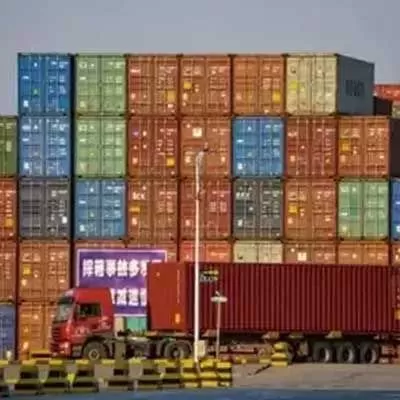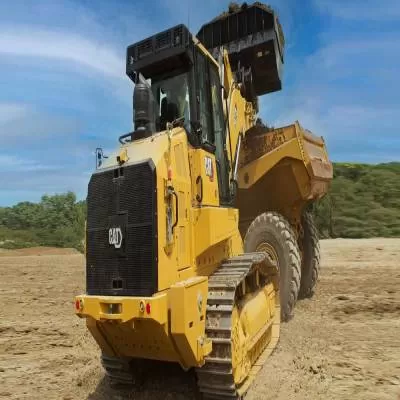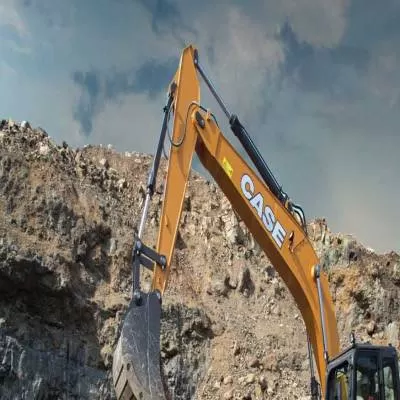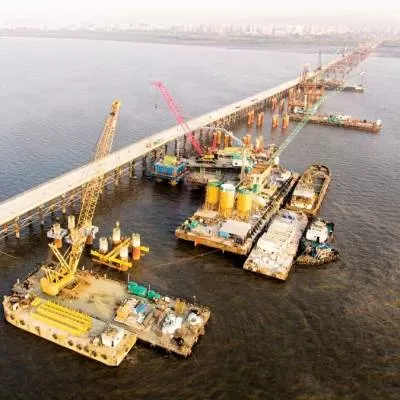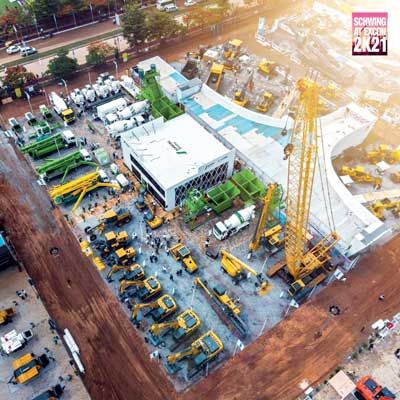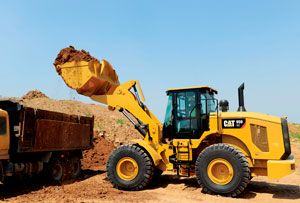
Down, not out
Demand for construction equipment is low across the spectrum and it is no different for earthmoving equipment. However, with project announcements having been made in recent months, a few vendors are starting to see a turnaround in certain geographies.
Changing fortunes?
“We registered higher demand for compactors in January 2014 than January 2013,” says AM Muralidharan, President, Volvo Construction Equipment India. “Most of this is from the states of Maharashtra, Rajasthan and Uttar Pradesh, where state road projects are getting underway. But demand for excavators and all kinds of loaders is down 25 per cent since 2012.”
“Currently, demand is low because of the economic situation,” says Amit Gossain, Executive Vice President-Marketing, Business Development and Corporate Affairs, JCB India. “Government initiatives in the past six months have certainly helped in gaining momentum. Still, a lot of groundwork remains to be done to accelerate project implementation. We expect the momentum to pick up in the coming months.”
“In recent months, the markets have slipped further, let alone shown some signs of improvement,” says Rajesh Shrivastava, General Manager, Marketing, Terex India. “We are hardly seeing any movement. Contractors, developers and infrastructure companies are not very upbeat about recent project announcements or clearances. They are sceptical about the way forward.”
Bright future
Notwithstanding the dull outlook and slow recovery prospects, TechNavio forecasts that the earthmoving equipment market in India will grow at a CAGR of 20.9 per cent over the period 2012-2016. It also forecasts that the Indian excavator market, a sub-segment of the former, will grow at a CAGR of 21.98 per cent over the period 2013-2018.
Given the infrastructure projects in the pipeline, like the upcoming Delhi-Mumbai Industrial Corridor, these demand projections may not be as farfetched as they seem. Gossain believes transportation, energy, telecommunications, water and sanitation projects could also drive demand. “In recent years, the Government has stepped up focus on rural infrastructure development covering housing, roads, irrigation, water supply and sanitation, under schemes like the Pradhan Mantri Gram Sadak Yojana and Indira Awaas Yojana,” he says. “Also, rural development will be a key growth enabler in times to come.”
“We expect activity to pick up in the roads sector, followed by the mining of stones and sand,” opines Shrivastava. According to Ajay Shankar, Country Manager, Caterpillar India, “Growth in infrastructure will enable demand for different kinds of earthmoving equipment. Long-term opportunities exist in power, roads, construction and mining. Significant investments will also go into developing ports, airports, railways and real estate. According to industry bodies, 994 km of highways have been awarded where work has to be started and 17,103 km of highways have to be awarded.”
Products with potential
Which products among the earthmoving equipment segment have the brightest prospects? Backhoe loaders are the most widely used construction equipment in India because of their excellent manoeuvrability and ability to multitask. As projects become more complex, however, Gossain sees the use of specialised machinery – tracked excavators, vibratory compactors and wheel loaders – growing as contractors and developers focus on meeting tight project deadlines.
“Crawlers and skid-steer loaders are two segments with good potential in the near future,” says Shrivastava.
After-sales expansion
A strong after-sales network is a must to ensure customer satisfaction and build lasting relationships with customers, both of which are crucial to maintain a competitive edge in the market. After-sales services also have the potential to contribute a healthy share of equipment vendors’ revenue. According to Shushmul Maheshwari, CEO, RNCOS, “More than 15 per cent of the revenue of global mining and construction equipment companies comes from spares and services. This strongly supports their profitability and evens out revenue volatility. As a result, manufacturers are enabled to competitively price their offerings and efficiently manage their product lifecycles. In contrast, spares and services contracts currently contribute only about 2 to 8 per cent to Indian construction equipment vendors’ revenue, mostly because of the local availability of non-OEM spares.” India is home to numerous construction equipment majors across the globe. In order to improve customer services, increase profitability and tap the after-sales revenue potential, various national and foreign brands are focusing on after-sales services. “Terex India is actively promoting annual service contracts and other parts service campaigns targeted at specific user segments such as plant hirers, road contractors and quarry operators,” shares Shrivastava.
“Volvo offers four levels of service contracts, each designed to cater to a certain class of Indian buyers. Very few Indian buyers (vis-à-vis the overseas scenario) want the provider to take over complete maintenance of the equipment and do preventive maintenance,” explains Muralidharan. “Most want services only during downtime with parts when required.”
JCB has seen growth in its market shares across all product categories in spite of the current challenges by focusing on developing new markets and strengthening its distribution network.
In particular, India’s highest selling earthmoving equipment, the backhoe loader, is mostly a retail-oriented market segment. Selling to a greater number of smaller players increases the need for an expansive after-sales service network. To minimise machine downtime for customers, market leader JCB has made sure that its customers do not have to travel beyond 50 km to reach a JCB outlet in any part of the country. “Our product support network spans over 575 outlets and 59 dealers, employing 4,500 JCB trained service engineers for after-sales services alone,” says Gossain.
Caterpillar relies on its dealer network with Gmmco and TIPL to offer customers strong sales and service support.
Rental opportunities
The construction equipment rental industry in India is very small as compared to its counterparts in Asian continents, such as China and Japan, but its growth prospects are quite bright. “Growth prospects are especially bright for earthmoving equipment such as backhoe loaders, hydraulic excavators, wheel loaders, motor graders and compaction equipment, as this is the most popular equipment currently being rented in India,” says Maheshwari.
In general, CCCL India takes earthmoving equipment on rent. Even so, the company prefers standard equipment manufacturers in that segment. Boopathi Gnanavelu, Head, Corporate Resource Planning, CCCL India, says this is because “Their efficiency in operations is proven. Spare parts are more easily available for equipment produced in large numbers. Quick replacements ensure minimum downtime. Another influencing factor is the vendors’ spread of service stations across the country. This helps rental companies ensure that their equipment stays in good working condition.”
For companies believing in buying earthmoving equipment, Boopathi emphasises the need to check to what extent the vendors focus on building long-term associations with customers and to stick to best-in-class products because the salvage value of standard equipment is higher.
Telling them apart
No doubt choice has widened for construction companies in the earthmoving equipment segment. Current players include Bharat Earth Movers, Tata Hitachi, Caterpillar Inc, Doosan Corp, Escorts Construction Equipment, Ingersoll-Rand plc, JCB India, Kobelco Construction Machinery Co, Leyland Deere, Mahindra & Mahindra, Terex Corp, Volvo Construction Equipment, etc. On the surface, construction companies are spoilt for choice. But do genuine differentiators exist between these various options?
According to Mayank Bansal, Principal, AT Kearney, “Today, construction companies have several OEM options in the earthmoving segment. Still there is a noticeable lack of differentiation between models of various available brands. Currently, most machines are priced for volume sales and hence tend to focus on cost as a differentiator. There is plenty of scope for companies to differentiate their offerings on other parameters, such as ‘customer service’ or ‘technology specifications.’ For instance, telematics has not yet been offered as a standard offering in most segments in India, but could be a key differentiator in the future.”
Volvo Construction Equipment has started to offer the CareTrack telematics system – but as an added feature. CareTrack provides the company and owners with monitoring information to reduce fuel costs, optimise performance and manage just one or even a whole fleet’s service plan in order to maximise uptime.
“Products from different players are only marginally different from each other,” says Gnanavelu. “Desirable differentiators are easy options to change attachments for different operations and automation that guides the operator to align, cut and grade the ground precisely by laser technology. Automation is especially important in earthmoving equipment and many available machines do not offer this feature. Players offering these technologies will really stand apart from the rest.”
Towards product differentiation
Some buyers believe significant differentiation is already visible in the market for earthmovers. “Intense competition has filled any existing product gaps and led to substantially differentiated products,” avers Vidhushekhar, Manager-Purchase, Valecha Engineering. “It has led to a number of same-category products, each with some distinct advantage over each other, which is why we pay close attention to the technological specifications of the machine under consideration. We also compare the tech specs of machines being considered with overall tech advancements, and consider our past experience with the vendor, price and the availability of efficient after-sales services.”
The good part of differentiation is that “buyers can identify a product that almost completely matches their needs,” explains Vishushekhar. The flip side is that product versatility comes down with differentiation. “Sometimes, to such an extent that companies must buy the next level or capacity product for a similar use as the earlier model does not suffice, which can lead to idling of machines,” he adds.
Muralidharan reports growing demand for Volvo’s line of compactors featuring a compactometer, specifically from municipal corporations in Maharashtra, for road projects. “Awareness is growing about the use of such features in improving the quality of projects outcomes, and to boost productivity,” he observes. “Whereas some road contractors just assume that four passes are needed for compaction, discerning customers are realising there are gains to be made by going about the job scientifically.”
Bansal believes that differentiation will become a reality when demand picks up. “Growth has taken a hit since the highs of 30-35 per cent of a few years ago. Still, the market is set for takeoff – it’s just waiting for the action to start.” Another positive outcome of growth would be the readier availability of specialised equipment that is currently being imported. “Consciousness is growing about the productivity benefits of larger-sized equipment, such as 50 tonne plus excavators and specialised attachments,” adds Bansal. “A pickup in demand for these equipment and attachments is poised to happen with increasing focus on productivity and timely completion of projects.”
May greater awareness be a harbinger of change!
Market projections
Earthmoving equipment: Excavators, backhoe loaders, wheel loaders, crawler dozers, motor graders, skid steer loaders
Leaders: Wheel loaders, crawler excavators, backhoe loaders are expected to account for over 70 per cent of the construction equipment market by 2016.
Compaction equipment, motor graders, skid steer loaders, crawler dozers, mini excavators, etc, are still smaller markets in terms of units sold.
Demand may be down for earthmoving equipment but this largest subset of the construction equipment sector can never really be out. What might propel it forward? CHARU BAHRI has some answers.Demand for construction equipment is low across the spectrum and it is no different for earthmoving equipment. However, with project announcements having been made in recent months, a few vendors are starting to see a turnaround in certain geographies.Changing fortunes?“We registered higher demand for compactors in January 2014 than January 2013,” says AM Muralidharan, President, Volvo Construction Equipment India. “Most of this is from the states of Maharashtra, Rajasthan and Uttar Pradesh, where state road projects are getting underway. But demand for excavators and all kinds of loaders is down 25 per cent since 2012.”“Currently, demand is low because of the economic situation,” says Amit Gossain, Executive Vice President-Marketing, Business Development and Corporate Affairs, JCB India. “Government initiatives in the past six months have certainly helped in gaining momentum. Still, a lot of groundwork remains to be done to accelerate project implementation. We expect the momentum to pick up in the coming months.”“In recent months, the markets have slipped further, let alone shown some signs of improvement,” says Rajesh Shrivastava, General Manager, Marketing, Terex India. “We are hardly seeing any movement. Contractors, developers and infrastructure companies are not very upbeat about recent project announcements or clearances. They are sceptical about the way forward.”Bright futureNotwithstanding the dull outlook and slow recovery prospects, TechNavio forecasts that the earthmoving equipment market in India will grow at a CAGR of 20.9 per cent over the period 2012-2016. It also forecasts that the Indian excavator market, a sub-segment of the former, will grow at a CAGR of 21.98 per cent over the period 2013-2018.Given the infrastructure projects in the pipeline, like the upcoming Delhi-Mumbai Industrial Corridor, these demand projections may not be as farfetched as they seem. Gossain believes transportation, energy, telecommunications, water and sanitation projects could also drive demand. “In recent years, the Government has stepped up focus on rural infrastructure development covering housing, roads, irrigation, water supply and sanitation, under schemes like the Pradhan Mantri Gram Sadak Yojana and Indira Awaas Yojana,” he says. “Also, rural development will be a key growth enabler in times to come.” “We expect activity to pick up in the roads sector, followed by the mining of stones and sand,” opines Shrivastava. According to Ajay Shankar, Country Manager, Caterpillar India, “Growth in infrastructure will enable demand for different kinds of earthmoving equipment. Long-term opportunities exist in power, roads, construction and mining. Significant investments will also go into developing ports, airports, railways and real estate. According to industry bodies, 994 km of highways have been awarded where work has to be started and 17,103 km of highways have to be awarded.”Products with potentialWhich products among the earthmoving equipment segment have the brightest prospects? Backhoe loaders are the most widely used construction equipment in India because of their excellent manoeuvrability and ability to multitask. As projects become more complex, however, Gossain sees the use of specialised machinery – tracked excavators, vibratory compactors and wheel loaders – growing as contractors and developers focus on meeting tight project deadlines.“Crawlers and skid-steer loaders are two segments with good potential in the near future,” says Shrivastava.After-sales expansionA strong after-sales network is a must to ensure customer satisfaction and build lasting relationships with customers, both of which are crucial to maintain a competitive edge in the market. After-sales services also have the potential to contribute a healthy share of equipment vendors’ revenue. According to Shushmul Maheshwari, CEO, RNCOS, “More than 15 per cent of the revenue of global mining and construction equipment companies comes from spares and services. This strongly supports their profitability and evens out revenue volatility. As a result, manufacturers are enabled to competitively price their offerings and efficiently manage their product lifecycles. In contrast, spares and services contracts currently contribute only about 2 to 8 per cent to Indian construction equipment vendors’ revenue, mostly because of the local availability of non-OEM spares.” India is home to numerous construction equipment majors across the globe. In order to improve customer services, increase profitability and tap the after-sales revenue potential, various national and foreign brands are focusing on after-sales services. “Terex India is actively promoting annual service contracts and other parts service campaigns targeted at specific user segments such as plant hirers, road contractors and quarry operators,” shares Shrivastava.“Volvo offers four levels of service contracts, each designed to cater to a certain class of Indian buyers. Very few Indian buyers (vis-à-vis the overseas scenario) want the provider to take over complete maintenance of the equipment and do preventive maintenance,” explains Muralidharan. “Most want services only during downtime with parts when required.”JCB has seen growth in its market shares across all product categories in spite of the current challenges by focusing on developing new markets and strengthening its distribution network.In particular, India’s highest selling earthmoving equipment, the backhoe loader, is mostly a retail-oriented market segment. Selling to a greater number of smaller players increases the need for an expansive after-sales service network. To minimise machine downtime for customers, market leader JCB has made sure that its customers do not have to travel beyond 50 km to reach a JCB outlet in any part of the country. “Our product support network spans over 575 outlets and 59 dealers, employing 4,500 JCB trained service engineers for after-sales services alone,” says Gossain.Caterpillar relies on its dealer network with Gmmco and TIPL to offer customers strong sales and service support.Rental opportunitiesThe construction equipment rental industry in India is very small as compared to its counterparts in Asian continents, such as China and Japan, but its growth prospects are quite bright. “Growth prospects are especially bright for earthmoving equipment such as backhoe loaders, hydraulic excavators, wheel loaders, motor graders and compaction equipment, as this is the most popular equipment currently being rented in India,” says Maheshwari.In general, CCCL India takes earthmoving equipment on rent. Even so, the company prefers standard equipment manufacturers in that segment. Boopathi Gnanavelu, Head, Corporate Resource Planning, CCCL India, says this is because “Their efficiency in operations is proven. Spare parts are more easily available for equipment produced in large numbers. Quick replacements ensure minimum downtime. Another influencing factor is the vendors’ spread of service stations across the country. This helps rental companies ensure that their equipment stays in good working condition.”For companies believing in buying earthmoving equipment, Boopathi emphasises the need to check to what extent the vendors focus on building long-term associations with customers and to stick to best-in-class products because the salvage value of standard equipment is higher.Telling them apartNo doubt choice has widened for construction companies in the earthmoving equipment segment. Current players include Bharat Earth Movers, Tata Hitachi, Caterpillar Inc, Doosan Corp, Escorts Construction Equipment, Ingersoll-Rand plc, JCB India, Kobelco Construction Machinery Co, Leyland Deere, Mahindra & Mahindra, Terex Corp, Volvo Construction Equipment, etc. On the surface, construction companies are spoilt for choice. But do genuine differentiators exist between these various options?According to Mayank Bansal, Principal, AT Kearney, “Today, construction companies have several OEM options in the earthmoving segment. Still there is a noticeable lack of differentiation between models of various available brands. Currently, most machines are priced for volume sales and hence tend to focus on cost as a differentiator. There is plenty of scope for companies to differentiate their offerings on other parameters, such as ‘customer service’ or ‘technology specifications.’ For instance, telematics has not yet been offered as a standard offering in most segments in India, but could be a key differentiator in the future.”Volvo Construction Equipment has started to offer the CareTrack telematics system – but as an added feature. CareTrack provides the company and owners with monitoring information to reduce fuel costs, optimise performance and manage just one or even a whole fleet’s service plan in order to maximise uptime. “Products from different players are only marginally different from each other,” says Gnanavelu. “Desirable differentiators are easy options to change attachments for different operations and automation that guides the operator to align, cut and grade the ground precisely by laser technology. Automation is especially important in earthmoving equipment and many available machines do not offer this feature. Players offering these technologies will really stand apart from the rest.”Towards product differentiationSome buyers believe significant differentiation is already visible in the market for earthmovers. “Intense competition has filled any existing product gaps and led to substantially differentiated products,” avers Vidhushekhar, Manager-Purchase, Valecha Engineering. “It has led to a number of same-category products, each with some distinct advantage over each other, which is why we pay close attention to the technological specifications of the machine under consideration. We also compare the tech specs of machines being considered with overall tech advancements, and consider our past experience with the vendor, price and the availability of efficient after-sales services.”The good part of differentiation is that “buyers can identify a product that almost completely matches their needs,” explains Vishushekhar. The flip side is that product versatility comes down with differentiation. “Sometimes, to such an extent that companies must buy the next level or capacity product for a similar use as the earlier model does not suffice, which can lead to idling of machines,” he adds.Muralidharan reports growing demand for Volvo’s line of compactors featuring a compactometer, specifically from municipal corporations in Maharashtra, for road projects. “Awareness is growing about the use of such features in improving the quality of projects outcomes, and to boost productivity,” he observes. “Whereas some road contractors just assume that four passes are needed for compaction, discerning customers are realising there are gains to be made by going about the job scientifically.”Bansal believes that differentiation will become a reality when demand picks up. “Growth has taken a hit since the highs of 30-35 per cent of a few years ago. Still, the market is set for takeoff – it’s just waiting for the action to start.” Another positive outcome of growth would be the readier availability of specialised equipment that is currently being imported. “Consciousness is growing about the productivity benefits of larger-sized equipment, such as 50 tonne plus excavators and specialised attachments,” adds Bansal. “A pickup in demand for these equipment and attachments is poised to happen with increasing focus on productivity and timely completion of projects.”May greater awareness be a harbinger of change!Market projectionsEarthmoving equipment: Excavators, backhoe loaders, wheel loaders, crawler dozers, motor graders, skid steer loadersLeaders: Wheel loaders, crawler excavators, backhoe loaders are expected to account for over 70 per cent of the construction equipment market by 2016.Compaction equipment, motor graders, skid steer loaders, crawler dozers, mini excavators, etc, are still smaller markets in terms of units sold.



